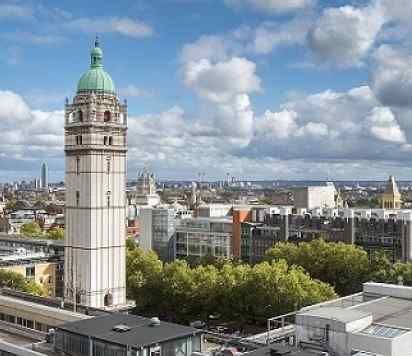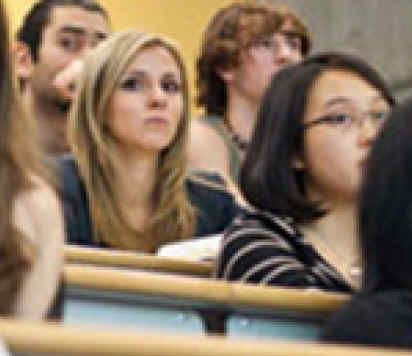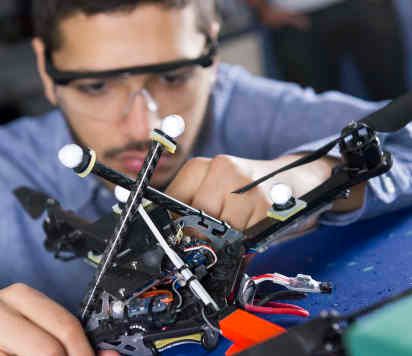Over the years, our graduates and staff have played a significant role in the development of the UK aerospace industry, which proved to be particularly important in the regeneration period after the Second World War. In more recent times the Department's research has been applied to other fields of engineering, leading to strong collaborations with Formula 1.
The Department boasts a large number of alumni who have been employed in F1, including chief designers and engineers.
Notable alumni
Flight Lieutenant Kirsty Moore
Kirsty Moore, who obtained a Masters in Aeronautical Engineering from Imperial College London, became the first female pilot to join Britain’s renowned Red Arrows aerobatic display team. Read more about Kirsty on Imperial's News page.
Andreas Mogensen
Andreas Mogensen received his Masters degree in Aeronautics Engineering in 1999 and has since qualified as an astronaut for the European Space Agency. During this time he has worked as a flight engineer on the International Space Station and was the first Danish citizen in space in 2015.
Find out more about Andreas on the European Space Agency website.
Professor Michael Crisfield
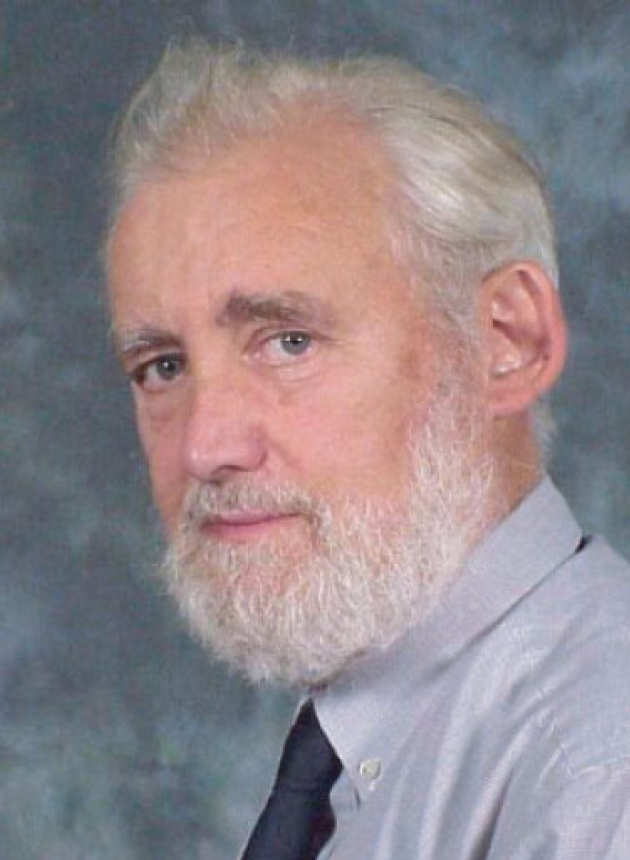 Michael Crisfield (1942-2002) graduated in Civil Engineering at Queen’s University in 1965; and received his PhD in 1970 for research on the Finite Element Analysis (FEA) of skew bridges.
Michael Crisfield (1942-2002) graduated in Civil Engineering at Queen’s University in 1965; and received his PhD in 1970 for research on the Finite Element Analysis (FEA) of skew bridges.
After a brief period at the Ministry of Development in Northern Ireland, Mike joined the Transport & Road Research Laboratory in 1971, where he remained until 1989. There he wrote his first influential book on FEA and developed some remarkable pieces of research, notoriously the solution procedures for snap-through problems: these are widely used today by most structural numerical simulation software.
In 1989, he became the first holder of the FEA chair in computational mechanics in the Department of Aeronautics at Imperial College London.
During this time, Crisfield received an IACM Research Achievement Award in recognition of his extraordinary achievements in the field of non-linear computational mechanics, wrote two more highly-cited books and also changed direction in his career, from steel and concrete to more lightweight materials - carbon composites.
For these materials, he contributed to develop the numerical tools which allow engineers to accurately model fracture problems involving crack propagation. These tools are called cohesive zone elements (among several other names), and have recently become a mandatory component for structural numerical simulation software.
In the latest moments of his career, Crisfield was in the top 20 most cited engineering researchers in the UK (not just in the field of computational mechanics).
Wee Siew Kim
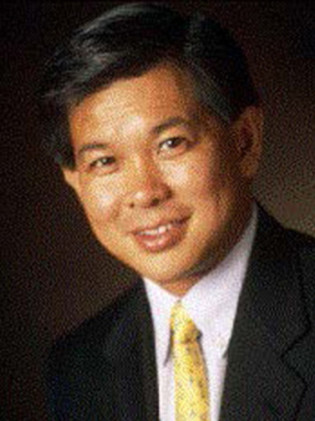 Mr Wee BSc MBA (b.1960) was awarded First Class Honours BSc from Imperial College in 1984 and a Master of Business Administration from Stanford University in 1991.
Mr Wee BSc MBA (b.1960) was awarded First Class Honours BSc from Imperial College in 1984 and a Master of Business Administration from Stanford University in 1991.
His career with the Singapore Technologies (ST) group began in 1984 as an engineer in ST Aerospace. In this position, Mr Wee contributed to the acquisition of aero-science capabilities and participated in the design of reengined A-4 Skyhawks.
By 1997, he was president of ST Aerospace. In 2001, Mr Wee became President of ST Engineering’s Europe operations. Mr Wee Siew Kim is the President, Defence Business, of ST Engineering, having occupied this position since May 2002. In 2004, Mr Wee was concurrently appointed Deputy CEO, overseeing the Aerospace and Marine sectors. Mr Wee is also a Member of Parliament for the Ang Mo Kio Group Representative Constituency in Singapore since 2001.
Professor John H. Argyris
 Professor Argyris, DScEng DE h.c.Dr.mult. FIC FRS FEng FRG HonFCGI HonFRAeS ASMechE FAAAS FASCE FAASc FAIAeA Inst.Memb.mult (1913-2004) is one of the inventors or creators of the Finite Element Analysis, which revolutionized engineering sciences.
Professor Argyris, DScEng DE h.c.Dr.mult. FIC FRS FEng FRG HonFCGI HonFRAeS ASMechE FAAAS FASCE FAASc FAIAeA Inst.Memb.mult (1913-2004) is one of the inventors or creators of the Finite Element Analysis, which revolutionized engineering sciences.
During his career, Prof Argyris has been Emeritus Professor of Aeronautical Structures at Imperial College (London, UK); Director of the Institute for Computer Applications (University of Stuttgart, Germany); Honorary Professor of the Northwestern Polytechnic (University of Xian), Honorary Professor (Technical University of Beijing) and Honorary Professor (Qinghua University Beijing ); and Chairman of the World Innovation Foundation.
He won a considerable number of prizes and medals: the World Prize in Culture and the 1984 Personality of the Year of the Centro Studie Ricerce delle Nazione Academy Italia, Silver Medal RAeS, Von Karman Medal ASCE, Copernicus Medal, Timoshenko Medal ASME, B Laskowitz Award with Gold Medal, Daidalus Gold Medal, Gold Medal Bulgarian Academy of Sciences, Henri Coenda Medal in Gold, Gold Medal Land Baden-Wurttemberg, Grand Cross of Merit of the FRG and Grand Cross of Merit with Star of the FRG, Einstein award (one of the USA's highest distinctions, given by the Einstein Foundation for Argyris’ momentous work on the Finite Element method and Chaos Theory).
Professor John Argyris is one of the only five researchers to have been presented with the Prince Philip Medal of the Fellowship of Engineering (for his participation the invention of Finite Element Analysis).
Dr Geoffrey Pope
Dr Pope BSc MSc PhD FREng FRAeS FCGI (1934-2004) joined the Hawker Aircraft Company in 1952. A year later, he became a student at Imperial College and in 1956 he graduated with first-class honours in Aeronautical Engineering.
In 1958, he concluded his MSc in the same department and then joined the Royal Aircraft Establishment, working on structural numerical modelling.
By the early 1970s, he became the head of the aerodynamics department and then took over all research on structures, aerodynamics, and new materials such as carbon composites in 1978. Shortly afterwards, he became responsible for weapons research.
In 1981 he moved to the MoD HQ, where he was assistant chief scientific adviser and then deputy controller and adviser in research and technology. He was director of the Royal Aircraft Establishment from 1984 until 1989.
Dr Pope was made a Companion of the Order of the Bath in 1986 and fellow of the City and Guilds of London Institute in 1982. In 1988, he was elected fellow of the Royal Academy of Engineering and he was a member of the Royal Aeronautical Society throughout his career.
Dr Pope finished his career as Pro-Chancelor of the University of Exeter. He joined the university’s council in the mid-nineties and chaired it from 1999.
Air Chief Marshal Sir Glenn Torpy
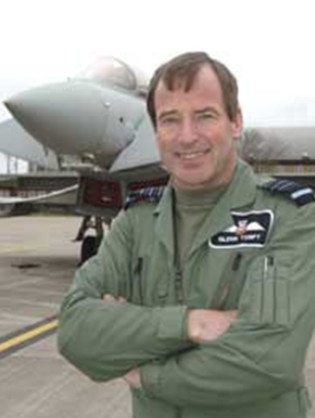 Air Chief Marshal Sir Glenn Torpy, KCB, CBE, DSO, BSc(Eng), FRAeS, RAF (b.1953) joined the Royal Air Force in 1974, after studying Aeronautical Engineering at Imperial College London (1971-1974).
Air Chief Marshal Sir Glenn Torpy, KCB, CBE, DSO, BSc(Eng), FRAeS, RAF (b.1953) joined the Royal Air Force in 1974, after studying Aeronautical Engineering at Imperial College London (1971-1974).
During the first Gulf war, he served with No 13 Squadron and was awarded the Distinguished Service Order in the Gulf Honours List. He also participated in the NATO intervention operation in Kosovo, for which he was made a Commander of the British Empire.
In 2003, he was the UK Air Contingent Commander for Operation IRAQI FREEDOM, for which he was awarded the US Legion of Merit for his part in the Coalition operation.
He graduated from the Royal Air Force Staff College in 1987, from the Royal College of Defence Studies in December 1997 and subsequently completed the Higher Command and Staff Course in April 1998.
Air Chief Marshal Torpy was made a Knight Commander of the Bath in January 2005, and assumed his current appointment as Chief of the Air Staff in 2006. He counts some 4300 hours of fast-jet flying.
Sir Colin Terry
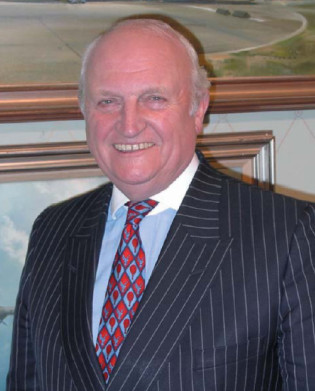 Air Marshal Sir Colin Terry KBE, CB, BSc(Eng), CEng, FREng is a renowned aeronautical engineer who spent 30 years in the Royal Air Force, after graduating from Imperial College in 1965 with a BSc in Aeronautics. He is still president of his college association.
Air Marshal Sir Colin Terry KBE, CB, BSc(Eng), CEng, FREng is a renowned aeronautical engineer who spent 30 years in the Royal Air Force, after graduating from Imperial College in 1965 with a BSc in Aeronautics. He is still president of his college association.
He became Air Marshal in 1997 and during his time in the Royal Air Force, as Head of Logistics and then Chief Engineer, he was responsible for 15,000 personnel and 30 aircraft types.
Sir Colin Terry is a fellow of Imperial College since 2005 and is also a member of the Courts of Imperial College and Cranfield University. He is a Council Member and Fellow of the City & Guilds of London Institute and a Freeman of the City of London.
Sir Colin Terry is an RAeS Council member since 1999 and Fellow since 1994. He has been President of the Council of the Royal Aeronautical Society and Chairman of the Engineering Council, member of the Advisory Committee for the Queens’s Award for Enterprise, chairman of the Learned Society Board since 2005, Fellow of the Royal Academy of Engineering and member of the Engineering Technology Board (ETB).
Sir Colin Terry's previous awards consist of a knighthood for his services to engineering; the Order of the Companion of the Bath (CB) and an OBE (for service in the Falklands). Sir Colin Terry shares The Economist's Class of 2002 with David Blunkett, Ken Livingstone, Iain Dun-can Smith, Charles Kennedy and Tony Blair.
Sir James Lighthill
At the age of 15, Sir Lighthill (1924 - 1998) won a scholarship to Trinity College, Cambridge, although he chose to wait until he was 17 years old before entering.
After graduating, he worked at the Aerodynamics Division of the National Physical Laboratory at Teddington until 1945, when he was elected a fellow of Trinity College.
In 1946, he was appointed Senior Lecturer at Manchester University, from where his group soon dominated research in fluids. In 1950, Lighthill was promoted to Beyer Professor of Applied Mathematics at Manchester University. While at Manchester, he launched two major new fields in fluid mechanics: aeroacoustics and non-linear acoustics.
Lighthill was elected fellow of the Royal Society of London in 1953, at the age of 29. In 1959, he was appointed director of the Royal Aircraft Establishment at Farnborough. His work in supersonics proved vital for the development of the Concorde.
He was elected a fellow of the Royal Aeronautical Society in 1961. In 1964, he was awarded the Royal Medal of the Royal Society and also became Royal Society Research Professor attached to Imperial College. Mathematical biofluiddynamics is a new field introduced by Lighthill during his time at Imperial College London. Also at this time, Lighthill founded the Institute of Mathematics and its Applications, as a reaction to what he perceived as a lack of support given to applied mathematics from government sources.
He became the institute’s first president in 1965-67. Between 1965 and 1969, he served the Royal Society first as its Secretary and then as its Vice-President.
In 1969, Lighthill succeeded to Paul Dirac as Lucasian Professor of Mathematics at the University of Cambridge. He occupied the post until 1979, being replaced by Stephen Hawking, when Lighthill became Provost of University College London.
Lighthill was awarded the Harvey Prize for Science and Technology (Israel Institute of Technology) in 1981, and the Gold Medal of the Institute of Mathematics and its Applications in 1982. He served as president of the International Union of Theoretical and Applied Mechanics from 1984 to 1988.
After Lighthill retired in 1989, he chaired the Special Committee on the International Decade for Natural Disaster Reduction, which was sponsored by the International Council of Scientific Unions. He held this position until 1995.
As well as in Britain, Lighthill was elected fellow of several academies abroad (American Academy of Arts and Sciences, 1958; the American Institute of Aeronautics and Astronautics, 1961; the American Philosophical Society, 1970; the French Academy of Sciences, 1976; the US National Academy of Science, 1976; and the US National Academy of Engineering, 1977).
He further holds over 20 honorary doctorates. We won the Royal Society Copley Medal in 1998. Lighthill received the Commander Order of Léopold in 1963 and was knighted in 1971.
Sir Arnold Hall
Sir Arnold Hall MA, HONDSC, HONDTECH, HONACGI, FRENG, FRAES, FRS led the team which investigated the Comet airliner disasters. The first crash happened in May 1953, and was followed by others in January 1954 and April 1954.
The investigation led by the then director of the Royal Aircraft Establishment at Farnborough was described as 'one of the most remarkable pieces of scientific detective work ever done'.
Sir Harnold Hall was at Imperial College from 1945 to 1951, and was later appointed fellow of Imperial College in 1963. In 1983, he won the Albert Medal from the RSA 'for his outstanding contributions to the aeronautical industry, and in particular to aeronautical engineering'.
Lieutenant-Colonel V. C. Richmond
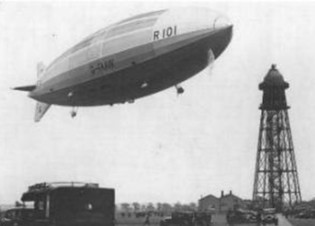 Lieutenant-Colonel V. C. Richmond (d.1930) led the R101 airship design team at Royal Airship Works, Cardington. Following the completion of the design, the smaller R33 airship was used to test external loads on the structure.
Lieutenant-Colonel V. C. Richmond (d.1930) led the R101 airship design team at Royal Airship Works, Cardington. Following the completion of the design, the smaller R33 airship was used to test external loads on the structure.
The R101's proving voyage was set from Cardington to India in 1930. Unfortunately, the airship crashed a few hours from Cardington, at Beauvais in France, killing Richmond and other 47 of its passengers and crew.
The official inquiry which followed found that the disaster had been caused, not by its design, but by a hydrogen leakage.
Richmond was a visiting lecturer at the Department of Aeronautics, Imperial College, in the 1920s.
Lord Kings Norton of Wotton Underwood
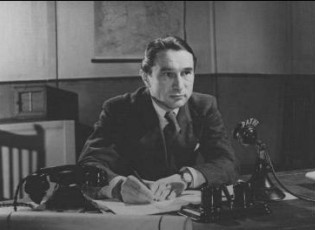 "When I look back....on the pattern of my long life, I see it dominated by three great projects - the design and construction of the R101, the development of the jet propulsion gas turbine, and Cranfield University. These are, so to speak, the high hills in a plain of diversified scenery." - Harold Roxbee Cox PhD, DIC, FEng, FIMechE, Hon FRAeS (1902-1997).
"When I look back....on the pattern of my long life, I see it dominated by three great projects - the design and construction of the R101, the development of the jet propulsion gas turbine, and Cranfield University. These are, so to speak, the high hills in a plain of diversified scenery." - Harold Roxbee Cox PhD, DIC, FEng, FIMechE, Hon FRAeS (1902-1997).
At the age of 16, Roxbee joined the Aircraft Design Department of the Austin Motor Company at Longbridge. He moved to London in 1922, starting his studies at Imperial College London. He was supervised by Sir Richard Glazebrook and Sir Leonard Bairstow, and obtained a PhD in aeronautics two years later.
His PhD work was on the aerodynamics and instabilities of wings, being his thesis entitled A Reciprocal Function Solution of Laplace's Equation in Two Dimensions with an Application to an Aerofoil Section.
In the summer of 1924, Roxbee went to work at the National Physical Laboratory, whose first director had been his supervisor Sir Richard Glazebrook. Roxbee then joined the design team for the R101 in Cardington (Royal Airship Works), at invitation of one of his favourite lecturers at Imperial College, Lt Col V. C. Richmond.
Roxbee later worked on the development of aeroplanes at the Royal Aircraft Establishment at Farnborough, contributing to aircraft safety with his studies on the problem of wing flutter and the stability of structures. When the Air Defence Department was founded at the Royal Aircraft Establishment, Roxbee became its head. Much of this work then was with barrage balloons.
Roxbee became Chief Technical Officer of the Air Registration Board in 1936. In 1940, when war was declared, Roxbee was transferred back to Farnborough as Superintendent of Scientific Research and was then moved to the new Ministry of Aircraft Production as Deputy Director of Scientific Research.
In 1943, as vice-president of the Royal Aeronautical Society, Roxbee chaired two meetings from which the blueprint for Cranfield University emerged. The College of Aeronautics, University of Cranfield, opened in 1946. In 1953, Roxbee was appointed Deputy Chairmen on the Board of Governors, and in 1962, he became the Board's Chairman.
In 1944, Roxbee became both Chairman and Managing Director of the nationalised Power Jets. In 1948, he was appointed Chief Scientist at the Ministry of Fuel and Power. In 1954, Roxbee left the civil service to begin a second career in industry. He became Chairman of the Council for Scientific and Industrial Research, and President of both the National Council for Quality and Reliability and the Institute of Marketing.
Roxbee was honoured with a life peerage in 1965, taking the title Lord Kings Norton of Wotton Underwood. His chosen motto was "Precision and Tolerance".
Sir Leonard Bairstow
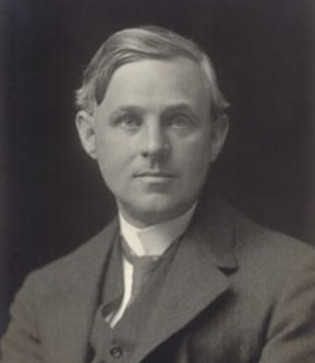 Sir Leonard Bairstow (1880-1963) is remembered for is work in aviation and for Bairstow's method for arbitrarily finding the roots of polynomials.
Sir Leonard Bairstow (1880-1963) is remembered for is work in aviation and for Bairstow's method for arbitrarily finding the roots of polynomials.
He worked at the National Physical Laboratory, where he became head of the Aerodynamics department, between 1909 and 1917.
He held the Zaharoff Chair of Aviation at Imperial College since 1920, and was head of the Department of Aeronautics until 1945.
Sir Richard Tetley Glazebrook
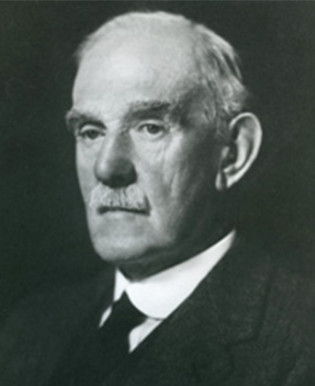 Sir Richard Glazebrook CB, KCVO FRS (1854, 1935), was born in Liverpool. After working in optics with James Clerk Maxwell, he was appointed demonstrator at the Cavendish Laboratory by Lord Rayleigh in 1879, and then in 1882 at the age of 28 he obtained a Fellowship of the Royal Society.
Sir Richard Glazebrook CB, KCVO FRS (1854, 1935), was born in Liverpool. After working in optics with James Clerk Maxwell, he was appointed demonstrator at the Cavendish Laboratory by Lord Rayleigh in 1879, and then in 1882 at the age of 28 he obtained a Fellowship of the Royal Society.
He was appointed first director of the NPL in 1900 (according to [1], but in 1899 according to [2,3]), a post he held until 1919. He was President of the Physical Society from 1903 to 1905. He became the first president of the Institute of Physics after the Physical Society adopted this new name.
Glazebrook obtained significant accomplishments in aeronautics, particularly on conditions of stability, and was appointed Zaharoff professor of aviation at Imperial College London from 1920 to 1923.
He received several medals for his achievements (Royal Society Hughes' medal, 1909; Albert medal of the Royal Society of Arts, 1918; gold medal of the Royal Aeronautical Society, 1933). He was knighted in 1917, received the Knight Commander of the Bath (KCB) in 1920 and Knight Commander of the Royal Victorian Order (KCVO) in 1934.
